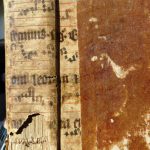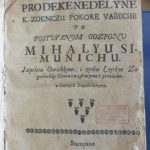The host volume of the fragment is a vernacular sermon collection of the famous Croatian preacher, Mihalj Šimunić, printed in Zagreb in 1697. The medieval antiphonal fragment was glued to the spine of the host volume to reinforce the binding. According to a Baroque handwritten note on the title page of the pastoral handbook, it was in the possession of a priest named Mihael Lončurić. The volume may have been used nearby Zagreb (possibly in the diocese?), and probably it was bound there.
A few neumes from the responsories of the Sundays of November (Historia Prophetarum) are visible on the fragment: parts of the third responsory of the second nocturn (R. Sustinuimus pacem V. Peccavimus cum patribus) and the first responsory of the third nocturn (R. Misit Dominus angelum V. Misit Dominus misericordiam) were preserved.
The surviving parts by lines:
- [R. Sustinuimus pacem et non venit… Non in perpetuum] obliviscaris [nos]
- [V. Peccavimus cum patribus nostris… iniquitatem] fecimus. Cog[n]o[vimus]. G[loria Patri et Filio…]
- [R. Misit Dominus angelum suum et conclusit] ora leonum et [non me contaminaverunt quia]
- [coram eo iusti]tia inventa es[t in me.]
- [V. Misit Dominus misericordiam… animam meam] eripu[it de medio catulorum leonum. Et non.]
The repetenda of the responsory Sustinuimus starts with the words “Cognovimus Domine”, while in Hungarian plainchant manuscripts and printed breviaries it starts with the words “Non in perpetuum”. An explanation for this unusual occurrence could be that the singers sang not only one verse of the last responsory of the second nocturn, but besides it, they sang the doxology as well. (The first letter of the Gloria after the sign of the repetenda proves that.) In the case of two verses, the repetenda was often different; it was sung in a gradually shortening form. The copyists of the fragment (the scribe and the notator) left the wide-spread repetenda Non in perpetuum after the doxology and lengthened the text of the first repetenda: namely they started it at an earlier point of the responsory’s main part (Cognovimus Domine).
The musical notation of the fragment is articulated, slightly cursive Messine-German-Hungarian Gothic notation, which was used in the entire Carpathian Basin during the 15th and 16th centuries. Attached (and unattached) scandicus; climacus made of a vertical line of points leaning slightly right; three-part pes; right-angled clivis and unique compound neumes are the characteristics of the notation. The traditional form of the climacus starting with two puncta is not apparent on the fragment: the climacus starts with one punctum both at the beginning and inside of the compound neumes. Since the scriptoria in Zagreb consequently used the climacus in this particular form in the second half of the 15th century, the fragment may have been copied locally.
The melodic variants of the responsories in question fit into the secular medieval Hungarian tradition (compare the fragment to the 15th–16th-century Buda antiphonal, fol. 145v, http://cantus.sk/image/14309).
Gábriel Szoliva OFM



